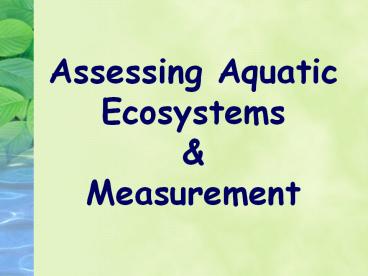Assessing Aquatic Ecosystems - PowerPoint PPT Presentation
1 / 32
Title: Assessing Aquatic Ecosystems
1
Assessing Aquatic Ecosystems Measurement
2
Aquatic Ecosystem Assessment
- The health of an aquatic ecosystem can be
determined by examining a variety of factors,
including - Water quality (physical chemical parameters)
- Aquatic macroinvertebrates
- Habitat
3
Sources of Contamination
USGS Water Science for Schools -
http//ga.water.usgs.gov/edu/waterquality.html
4
Water Quality
- Physical
- Stream flow, turbidity, temperature
- Chemical
- Dissolved oxygen (D.O.)
- pH
- Alkalinity
- Conductivity
- Phosphorous
- Nitrates
- Chlorine and chloride
- Heavy metals
- Organic compounds
5
Measuring Stream Flow
6
Turbidity tied to Conductivity
- Measure of water clarity
- Based on suspended material in water (soil,
plankton, microbes, etc.)
7
Turbidity
- Affected by
- Weather
- Stream flow velocity
- Erosion
- Run-off discharge
- Excessive algal growth
8
Turbidity
- Turbidity has an effect on
- Water color light penetration
- Temperature dissolved oxygen
- Survival of fish invertebrates
9
Temperature
- Optimal temp. range depends on species
- Temp. of lower order (closer to headwaters)
streams is usually lt 20C - Affected by
- Water sources discharges
- Weather seasons
- Riparian vegetation
10
Temperature
- Temp. affects
- Rate of biological chemical reactions
- Higher temps?
- Dissolved oxygen levels
- Higher D.O.?
- Sensitivity of aquatic life
11
Dissolved Oxygen (DO)
- Affected by
- Photosynthesis Respiration
- Riparian vegetation
- Input of organic material
- Temperature
- Stream flow
- Turbidity
- Decomposition
12
Dissolved Oxygen (DO)
- Most aquatic life requires DO levels of 5 - 6 ppm
to thrive - Levels lt 3 ppm are stressful
13
pH
- Measure of the alkalinity or acidity of the water
- Tolerance varies based on species
- Optimal range for most aquatic life is a pH of
6.5 8.0
14
pH
- Affected by
- Stream geology
- Alkalinity
- Acid precipitation
- Wastewater discharges
- Mining of coal or metals
- pH has an effect on
- Biological and chemical processes
- Solubility of elements compounds
- Survival of aquatic life
15
Alkalinity
- Measure of the buffering capacity
- Helps maintain pH of stream
- Highly dependent on stream geology
- Produced by leaching of carbonate/bicarbonate
from rocks - Levels between 100 200 ppm will stabilize pH
16
Conductivity (tied to Turbidity)
- General measure of water quality
- Related to ion concentration
- Affected by
- Geology of stream
- Discharges to stream (ex sewage)
- U.S. streams range from 501500 µs/cm
- 150500 µs/cm good range for most fish
macroinvertebrates
17
Phosphorus (tied to Nitrogen)
- Essential nutrient for plants, algae, and animals
- Phosphorus is usually found as part of phosphate
(PO43-) - Aquatic ecosystems have both inorganic and
organic PO43- - Plants require inorganic PO43- animals can use
both
18
The Phosphorus Cycle
19
Phosphorus
- Usually in short supply in aquatic ecosystems
- Unpolluted waters lt 0.03 mg/L
- Critical level is 0.1 mg/L
- Sources of phosphorus
- Soils and rocks
- Decomposition
- Wastewater
- Run-off (fertilizers and waste)
20
Eutrophication
- Increased phosphorus can lead to overgrowth of
algae aquatic plants - which leads to a chain of events that ends in
oxygen depletion.
21
Nitrates tied to Phosphates
- A form of nitrogen found in aquatic ecosystems in
the following forms - ammonia (NH3), nitrates (NO3-), nitrites (NO2-)
- Nitrates are an essential nutrient for plants and
algae - Natural levels in water lt 1 mg/L
22
The Nitrogen Cycle
23
Nitrates
- High levels along w/ phosphorus can lead to
eutrophication - Sources of nitrates
- Decomposition wastes
- Wastewater
- Run-off (waste fertilizers)
24
Chlorine Chloride
- Low levels of chloride may be found naturally
(lt16 mg/L is normal) - Sources of chloride (Cl-)
- Soil, rocks, minerals
- Decomposition wastes
- Street salt, wastewater, industry
- Chlorine (Cl2)should not be present
- Indicates input from municipal water source
25
Other Water Quality Concerns
- Metals (copper, iron, mercury, etc.)
- Pesticides
- Organics (PCBs, PAHs, etc.)
- Fecal coliform bacteria
26
Ways to Assess Water Quality
- Chemical tests
- Physical tests
- Biological tests
27
Measurement in the Field
- Always use Metric!
- Length
- 1 mm width of a dime
- 1 cm as wide as your pinky (10x dime)
- 1 m as tall as a doorknob (100x pinky)
- Temperature Celsius!
- Volume
- 1 mL 1 cm3 10 drops of water
- 1 L 1 quart (4 cups)
28
Micro Hike
- Measuring length discussing relative size
- Lets measure some things!
29
Micro Hike Lesson
- C.L.O.S.E. II students
30
Whats Hot Whats Not
- Measuring Temperature and discussing relative
temperatures - What is the temperature under your arm in
Celsius? Add 1 and this is your body
temperature. - What is the temperature of the ice water in
Celsius? - What is the temperature of the tap water in
Celsius?
31
Whats Hot Whats Not Lesson
- C.L.O.S.E. II students
32
Reading graduations
- Do not think that this is easy for students
A Drop in the Bucket

